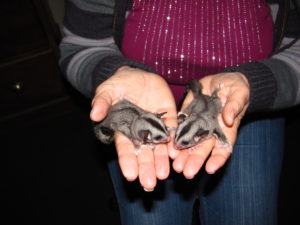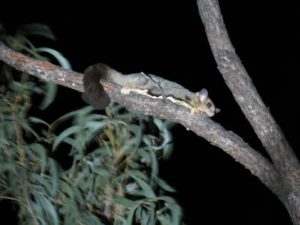
You need to get the spotlight out at night to try to find these little critters. Widely spread across northern and eastern Australia, the Sugar Glider (Petaurus breviceps) is common within the Maranoa Local Government area and around the township of Roma.
Belonging to the gliding possum family, their most distinguishing feature is the flap of loose skin (membrane) that extends between the fifth finger of their hand and the first toe of their foot. When stretched out by spreading its front and back limbs this skin becomes a wing and allows the Sugar Glider to soar up to 100 metres between trees. To land they raise their body and grip on the tree with their sharp claws. They also use these claws to climb up and down tree trunks and along branches.
The head and body length of an adult sugar glider is generally between 15 to 21 centimeters, with their tail being as long or longer than their body. They use their tail to help control the
direction of their glide. Being omnivorous, they are known to have a sweet tooth and enjoy flower nectar, acacia gum, eucalypt sap, insects and spiders. They are also nocturnal, meaning they are active at night and sleep during the day in nests generally made up of leaves in tree hollows. Found in forests and woodlands, old growth trees with hollows are an important habitat for the Sugar Glider, as they provide shelter and food. Creeks and watercourses are some of their favourite areas, however they can also be found on hill tops and ridges.
An arboreal species, the Sugar Glider rarely descends to the ground where it is more prone to predators. There are still animals that they need to be wary of at night, when they are foraging and playing, including owls and cats.

Petaurus breviceps – Sugar Gliders found orphaned near Roma QLD
Sugar Gliders are generally found in groups or ‘clans’. Up to seven adults and their young have been known to share a nest. Within themselves they are quite social, however should other clans come close by they will aggressively protect their territory which the males mark with scent from their chest glands.
The female Sugar Glider commonly gives birth to twins after a gestation period of around 16 days. After birth the young Gliders attach to a teat in the mother’s pouch and here they stay for around 40 days before emerging. It is not until another month after this that they leave the pouch and spend time riding on their mother’s back as she forages. They don’t become independent until around 7 to 10 months. The young females often remain with the group, however her brothers are forced to disperse and look for or form their own clan. They generally live between 4 and 9 years in the wild, depending on seasons, availability of food and shelter and predator impacts.
Sugar Gliders are highly vocal, with different sounds used for different occasions. If something is invading their territory they emit an intimidating chattering sound. When they are calling to others in trees they have a high pitched ‘yap, yap’. When they’re in the nest it is not uncommon to hear growling noises as they make contact with each other.
Next time you’re outdoors at night check the trees around you for eye shine and if you’re lucky enough to see a Sugar Glider watch as it glides with speed and precision between the trees. National Parks, like Carnarvon Gorge National Park, north of Roma is a great place to search if by yourself. Otherwise join one of BOOBOOK Ecotours and we’ll help you uncover animals like this and other Australian hidden wonders.


